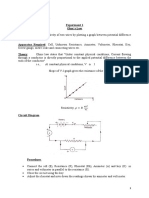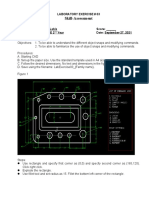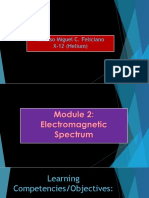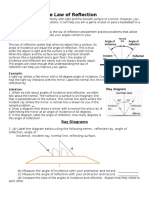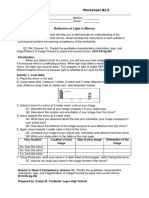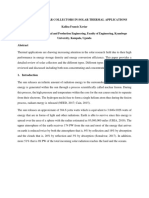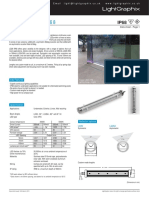XII Physics Practicals and Activities 202425
Uploaded by
Neil DongreXII Physics Practicals and Activities 202425
Uploaded by
Neil DongreCLASS –XII –PHYSICS PRACTICAL (2024-25)
Instructions
Practical file should be written neatly and legibly.
Circuit diagrams must be drawn on the plane side (left side) of the file with pencil.
Observation table must be drawn on the plane side (left side) of the file with pencil.
Graph should be drawn based on the readings recorded.
Write the experiment number with the aim in the index page.
SECTION A
Experiment No: 1
Aim: To determine resistivity of two wires by plotting a graph for potential difference versus
current.
Apparatus: Two experimental wires, a voltmeter (0-3) V and an ammeter (0-3) A of appropriate
range, a battery eliminator, a rheostat, a metre scale, one way key, connecting wires and a piece of
sand paper, screw gauge.
Theory
According to the Ohm’s law the current flowing through a conductor is directly proportional to the
potential difference across its ends provided the physical conditions (temperature, dimensions,
pressure) of the conductor remains the same.
Circuit diagram
Procedure
1. Arrange the apparatus in the same manner as given in the diagram.
2. While making connections ensure that positive marked terminals of voltmeter and ammeter
are joined towards the positive terminal of the battery.
3. Determine the least count of voltmeter and ammeter, and also note the zero error, if any.
4. Adjust the sliding contact of the rheostat such that a measurable current passes through the
resistance coil or the resistance wire.
5. Note down the value of potential difference V” from voltmeter and current I from ammeter.
6. Take at least five sets of independent observations.
7. Repeat the same steps 1 to 6 for the second and the third wire.
8. Record your observations
For Specific Resistance
1. Cut the resistance wire at the points where it leaves the terminals, stretch it and find its
length by using a metre scale. Do the same with all the wires
2. Measure the diameter of the wires with the help of screw gauge.
3. Record your observations.
Observations
1. Range of the given ammeter = ____
2. Range of the given voltmeter = ______
3. Least count of ammeter = ___________
4. Least count of voltmeter = ___________
5. Zero error in ammeter = ________
6. Zero error in voltmeter = __________
7. Zero correction for ammeter = _______
8. Zero correction for voltmeter = _________
Observation table
Sl No Wire 1 Voltmeter Ammeter Resistance =
reading (V) reading(A) V/I
(Ω)
1 l1
2
3
4
5
Mean R =
Sl No Wire 2 Voltmeter Ammeter Resistance =
reading (V) reading(A) V/I
(Ω)
1 l2
2
3
4
5
Mean R =
Calculations:
1. Find ratio of V and I for each set of observations.
2. Plot a graph between potential difference V and current I taking V along X-axis and I along Y-
axis. The graph comes to be a straight line.
(Graph should be drawn only after taking the observations)
For Specific Resistance
L.C of the given screw gauge = ________¿mm
Zero error = ___________mm
Zero correction = __________mm
Table: To find the diameter of the resistance wires
S.No. Diameter(d) = MSR+CSR x LC (in mm) Mean Diameter = (d1+d2+d3)/3
1 d1=
2 d2=
3 d3=
Calculation of specific resistance
Result
1. Resistivity of wire 1= ………… Ωm.
2. Resistivity of wire 2= ………… Ωm.
3. The graph between V and I is a straight line.
Precautions (any 3 to be recorded)
1. The connections should be neat, clean and tight.
2. Thick copper wires should be used for the connections after removing the insulations near
their ends by rubbing with sand paper.
3. Voltmeter and ammeter should be of proper range.
4. A low resistance rheostat should be used.
5. The key should be inserted only while taking observations to avoid heating of resistance
(otherwise its resistance will increase).
Sources of error
1. The instrument screws may be loose.
2. Thick connecting wires may not be available.
3. Rheostat may have high resistance.
Experiment No: 2
Aim : To find resistance of a given wire using metre bridge.
Apparatus
A metre bridge (slide wire bridge), Battery eliminator, a galvanometer, a resistance box, a jockey, a
one-way key, a resistance wire, a set square, connecting wires and a piece of sand paper.
Theory
(i) The unknown resistance X is given by
Procedure
1. Arrange the apparatus as shown in the diagram.
2. Connect the resistance wire whose resistance is to be determined in the right gap between C
and B.
3. Connect resistance box of low range in the left-hand gap between A and B.
4. Take out some resistance (say 2 ohm) from the resistance box, plug the key K.
5. Touch the jockey gently first at left end and then at right end of the bridge wire. If the
galvanometer shows deflections in opposite directions, the connections are correct.
6. Move (slide) the jockey gently along the wire from left to right till galvanometer gives zero
deflection. The point where the jockey is touching the wire is null point D.
7. Note position of point D
8. Take at least four sets of observations in the same way by changing the value of resistance.
9. Record your observations.
Observation table
Table for unknown resistance (X)
Sl. No Resistance from Length AD Length DC = (100-l) X = R(100-l)/l
the box l (cm) (cm) (Ω)
Mean resistance = ……………. Ω
Result
1. The value of unknown resistance X =……… Ω
Precautions (Any three)
1. The connections should be neat, clean and tight.
2. All the plugs in the resistance box should be tight.
3. Move the jockey gently over the bridge wire and do not rub it.
4. The plug-in key K should be inserted only when the observations are to be taken.
5. Null point should be brought between 45 cm and 55 cm.
6. Set square should be used to note null point to avoid error of parallax.
7. At one place, diameter of wire should be measured in two mutually perpendicular
directions.
8. The wire should not make a loop.
Sources of error (Any three)
1. The instrument screws may be loose
2. The plugs may not be clean
3. The wire may not have uniform thickness
4. The screw gauge may have faults like back lash error and wrong pitch.
Experiment No: 3
Aim:
To verify the laws of combination (series) of resistances using a metre bridge
Apparatus
A metre bridge, battery eliminator, a galvanometer, a resistance box,a jockey, two resistance wires
or two resistance coils known resistances, a set square, sand paper and connecting wires.
Theory
where R is the resistance from the resistance box in the left gap and l is the length of the metre
bridge wire from zero ends up to balance point.
Circuit diagram
Procedure
1. Mark the two resistance coils as r1 and r2.
2. Find r1 and r2 using meter bridge, individually.
3. Connect the two resistors r1 and r2 in series as shown in the circuit in the right gap of metre bridge
and find the resistance of this combination. Take at least three sets of observations.
4. Record your observations as follows.
Observations
Table for length (1) and unknown resistance (X)
Calculations
Experimental value of Rs = ……
Theoretical value of Rs = r1 + r2 = ……
Difference (if any) = ……
Result
Within limits of experimental error, experimental and theoretical values of Rs are same. Hence, law
of resistances in series is verified.
Precautions (Any three)
1. The connections should be neat, clean and tight.
2. Thick copper wires should be used for the connections after removing the insulations near
their ends by rubbing with sand paper.
3. Voltmeter and ammeter should be of proper range.
4. A low resistance rheostat should be used.
5. The key should be inserted only while taking observations to avoid heating of resistance
(otherwise its resistance will increase).
Sources of error (Any three)
1. The instrument screws may be loose
2. The plugs may not be clean
3. The wire may not have uniform thickness
4. The screw gauge may have faults like back lash error and wrong pitch
Experiment No: 4
Aim
To determine the resistance of a galvanometer by half-deflection method and to find its figure of
merit.
Apparatus
Galvanometer, a voltmeter, battery eliminator, two (10,000 Ω and 200 Ω) resistance boxes, two
one-way keys, a rheostat, a screw gauge, a metre scale, an ammeter of given range, connecting
wires.
Theory
Circuit diagram
Procedure
(a) Resistance of galvanometer by half deflection method
1. Mak
e
the
connections as in diagram.
2. Take out the high resistance (say 2000 Ω) from the resistance box R and insert the key K1 only.
3. Adjust the value of R so that deflection is maximum, even in number and within the scale.
4. Note the deflection. Let it be θ.
5. Insert the key also and without changing the value of R, adjust the value of S, such that
deflection in the galvanometer reduces to exactly half the value obtained in step 4
6. Note the value of resistance S.
7. Repeat steps 4 to 6 three times taking out different values of R and adjusting S every time.
(b) Figure of merit
1. Make connections as in circuit diagram.
2. Adjust the value of R to obtain a certain deflection (say 30 divisions) when the circuit is closed.
3. Note the values of resistance R and deflection θ.
4. Now change the value of R and note the galvanometer deflection again.
5. Repeat the steps
6. Find the figure of merit k using the formula.
Observations and Calculations
1. Table for resistance of the galvanometer by half deflection method
2. Ta
ble
for
figure of merit
Result
1. Resistance of given
galvanometer =_______ Ω
2. Figure of merit of given galvanometer = ___________A/div
Precautions (Any three)
1. All the connections should be neat, clean and tight.
2. All the plugs in resistance boxes should be tight.
3. The e.m.f. of cell or battery should be constant.
4. Initially a high resistance from the resistance box (R) should be introduced in the circuit
(otherwise for small resistance an excessive current will flow through the galvanometer or
ammeter can be damaged).
Sources of error (Any three)
1. The screws of the instruments may be loose.
2. The plugs of resistance boxes may not be clean.
3. The e.m.f. of battery may not be constant.
4. The galvanometer divisions may not be of equal size.
Activity No: 1
Aim: To assemble a household circuit comprising three bulbs, three (on/off) switches, a fuse and a
power source.
Material required:
Three bulbs (6 V, 1W) each, fuse of 0.6 A, main switch a power supply (battery . eliminator), three
(on/off) switches flexible connecting wire with red and black plastic covering, a fuse wire.
Supplementary: Main electric board with a two-pin socket and main switch.
Diagram
Procedure
1. Connect the bulbs B1, B2 and B3 in series with switches S1, S2 and S3 respectively and connect
each set of B-S in parallel with each other.
2. Connect main supply to a step-down transformer (battery eliminator) to get required voltage
from 0 to 10 V (0, 2, 4, 6, 8 and 10 V).
3. Connect the mains fuse M.S. in series with the power supply (battery eliminator).
4. Connect an A.C. ammeter in series with the B-S set.
5. Connect one end of power supply to one end of B-S set.
6. Check the circuit one again to ensure that household circuit is complete.
7. Gradually increase the current to 0.75 A, the fuse must bum off at about 0.6 A.
Activity No: 2
Aim: To assemble the components of a given electrical circuit.
Apparatus and material
Apparatus: A voltmeter and an ammeter of appropriate range, a battery, a rheostat, one way key.
Material: An unknown resistance or resistance coil, connecting wires, a piece of sand paper.
Diagram
Procedure
1. Connect the components (Resistors, inductors etc.) in series with each other as shown in
diagram and then in series with the battery.
2. Connect the ammeter in series with the circuit, to measure the current.
3. Connect the voltmeter in parallel to the resistor, to measure the potential difference.
4. Connect the switch in series with the battery.
5. Assembly of the electrical components in electric circuit is complete.
Utility
It is used for measuring an unknown resistance
Activity No: 3
Aim: To draw the diagram of a given open circuit comprising at least a battery, resistor/rheostat,
key, ammeter and voltmeter. Mark the components that are not connected in proper order and
correct the circuit and also the circuit diagram.
Apparatus and material
A battery eliminator or a battery (0 to 6 V), rheostat, resistance box (0 to 100 £2), two or one way key. D.C.
ammeter (0-3) A and a D.C. voltmeter (0-3) V.
Theory
An open circuit is the combination of primary components of electric circuit in such a manner that on closing
the circuit no current is drawn from the battery.
Circuit Diagram
Procedure
Ammeter: It should be connected in series, with the battery eliminator.
Voltmeter: It should be connected in parallel to the resistor.
Rheostat: It should be connected in series (in place of resistance coil) with the battery eliminator.
Resistance coil: It should be connected in parallel (in place of rheostat).
One way key: It should be connected in series to the battery eliminator.
Correct circuit diagram: (Components connected in proper order)
SECTION B
Experiment No: 5
Aim: To find the focal length of a convex lens by plotting graphs between u and v or between 1/u
and 1/v.
Apparatus
An optical bench with three uprights (central upright fixed, two outer uprights with lateral
movement), a convex lens with lens holder, two optical needles, (one thin, one thick) a knitting
needle and a half metre scale.
Theory
The relation between u, v and f for a convex lens is
where,
f = focal length of convex lens
u = distance of object needle from optical centre of the lens
v = distance of image needle from optical centre of the lens.
Ray diagram
Procedure
To determine rough focal length
1. Mount the concave mirror in mirror holder.
2. Go out in the open and face the mirror towards distant tree or building.
3. Obtain the image of the tree or the building on a white painted wall (screen) and move the
mirror forward and backward to get a sharp image on the wall.
4. Measure the distance between the mirror and the wall (screen). This will be equal to the
rough focal length of the mirror.
To set the lens
5. Clamp the holder with lens in a fixed upright and keep the upright at 50 cm mark.
6. Adjust the lens such that its surface is vertical and perpendicular to the length of the optical
bench.
7. Keep the upright fixed in this position throughout.
To set the object needle
8. Take the thin optical needle as object needle (O). Mount it in outer laterally movable upright
near zero end.
9. Move the object needle upright and clamp it at a distance (in full cms) nearly 1.5 times the
obtained rough focal length of the lens.
10. Adjust height of the object needle to make its tip lie on horizontal line through the optical
centre of the lens.
11. Note the position of the index mark on the base of the object needle upright.
To set the image needle
12. With left eye closed, see with the right open eye from the other end of the optical bench. An
inverted and enlarged image of the object needle will be seen. Tip of the image must lie in the
middle of the lens.
13. Mount the thick optical needle (image needle) in the fourth upright near the other end of the
optical bench.
14. Adjust the height of the image needle so that its tip is seen in line with the tip of the image
when seen with right open eye.
15. Move the eye towards right. The tips will get separated. The image tip and the image needle
tip have parallax.
16. Remove the parallax tip to tip.
17. Record the position of the index marks on the base of upright of the lens, the object needle
and the image needle in the table against observation 2.
To determine index correction
18. Find the index correction for distance between optical centre of lens and tip of the object
needle and also for distance between optical centre of lens and tip of the image needle as
described.
To get more observations
19. Move object needle upright towards mirror in steps of 1 cm to get observation 2 and 1.
Repeat the experiment.
20. Move object needle upright away from mirror (from position of observation 2) in steps of 1
cm to get observations 4, 5 and 6. Repeat the experiment.
21. Note the position of the index mark on base of the image needle upright.
Observations
1. Rough focal length of the given convex lens = …….cm
2. Actual length of the knitting needle x=…….cm
3. Observed distance between the object needle and the lens
4. when knitting needle is placed between them y =…….cm
5. Observed distance between the image needle and the
6. lens when knitting needle is placed between them z =…….cm
7. Index correction for the object distance u, x -y =…….cm
8. Index correction for the image distance v, x-z =…….cm
Calculations of focal length by graphical methods:
(i) u-v Graph. Select a suitable but the same scale to represent u along X’-axis and v along Y-
axis. According to sign conventions, in this case, u is negative and v is positive. Plot the
various points for different sets of values of u and v from observation table second quadrant.
The graph comes out to be a rectangular hyperbola as shown in graph between u and v.
Draw a line OA making an angle of 45° with either axis (i.e., bisecting ∠YOX’) and meeting
the curve at point A. Draw AB and AC perpendicular on X’- and Y-axes, respectively.
The values of u and v will be same for point A. So the coordinates of point A must
Result
The focal length of the given convex lens as determined from
Precautions
1. Tips of the object and image needles should lie at the same height as the centre of the lens.
2. Parallax should be removed from tip to tip by keeping eye at a distance at least 30 cm away
from the needle.
3. The object needle should be placed at such a distance that only real, inverted image of it is
formed.
4. Index correction for u and v should be applied.
Sources of error
1. The uprights may not be the vertical.
2. Parallax removal may not be perfect.
Experiment No: 6
Aim: To determine angle of minimum deviation for a given prism by plotting a graph between
angle of incidence and angle of deviation.
Materials Required
A drawing board, a white sheet of paper, a prism, drawing pins, pencil, a half-metre scale, office
pins, protractor, graph paper
Theory
Refraction takes place when a light ray travels from one medium to another resulting in deviation
of the emergent ray from that of the incident ray. Following is the refractive index of the material
used in the prism:
Ray diagrams
Procedure
1. Place the white sheet of paper on the drawing board and fix it with the help of drawing pins.
2. XX’ is the straight line which is drawn parallel to the length of the paper such that it is in the
middle of the paper.
3. Mark points Q1, Q2, Q3…… on the straight line XX’ at a distance of 5 cm each.
4. N1Q1, N2Q2,… are the normals that are drawn on the points Q1, Q2,… as shown in the ray
diagram.
5. Make angles of 35°, 40°,….,60° by drawing straight lines R1Q1, R2Q2,…….. With respect to the
normals.
6. To take one edge of the prism for all the observation, mark any corner of the prism as A.
7. Place the prism with its refracting face AB on the line XX’ and on the point Q1 and also in the
middle of AB.
8. Mark the boundary of the prism.
9. On the line, R1Q1, fix office pins vertically and mark them as P1 and P2. the distance between
these pins should not be less than 10mm.
10. Through prism face, AC, look for the images of the points P1 and P2.
11. Close your left eye and with the right eye open bring it in line with the two images.
12. Fix the other two office pins vertically and name them as P3 and P4. These pins should be
10cm apart from each other. P3 and P4 should be in one straight with respect to the images of
P1 and P2.
13. Encircle the pricks of pins P3 and P4.
14. For points, Q2, Q3,…. for angle 35 ͦ , 40°, 45°,…..55°, repeat the steps 7 to 13.
To measure D in a different case
1. To get emergent rays S1T1, S2T2,….. draw straight lines through P4 and P5.
2. Inward the boundary of the prism to produce T1S1, T2,S2….. so that they meet incident rays
R1Q1, R2Q2,…. at points F1, F2,…
3. To obtain the angle of deviation D1, D2,…. measure the angles K1F1S1, K2F2,S2,…….
4. Note these angles.
To measure angle A
1. To get angle A, measure the angle BAC in the boundary of the prism.
2. Record the observations.
Observations
The angle of prism, A =……
Calculations
To plot the graph between the angle of incidence ∠i and the angle of deviation ∠D, take ∠i along the
x-axis and ∠D along the y-axis. Minimum deviation Dm can be found from the graph which would
be corresponding to the lowest point in the graph.
Result
The angle of minimum deviation, Dm = ………
Angle of minimum deviation, Dm = ……..
The graph indicates that the angle of incidence increases, the angle of deviation first decreases to
attain the minimum value of Dm and then increases as the angle of incidence increases.
Precautions
35°-60° is the angle of incidence that needs to be maintained.
The placement of the pins must be vertical.
The placement of two pins should be such that the distance is not more than 10mm.
To represent incident and emergent rays, arrowheads must be marked.
The angle of prism used should be the same for all the observations.
Sources of Error
The pricks made by the pins might be thick.
Angles might go wrong while measuring them.
Experiment No: 7
Aim: To determine refractive index of a glass slab using a travelling microscope.
Materials Required
3 glass slabs of different thickness but the same material, a travelling microscope, Lycopodium
powder
Theory
When a glass slab is placed on a horizontal surface, and its bottom surface is viewed from the top, due to
refraction, it appears to be elevated. The apparent thickness of the slab is determined from the distance
between the apparent bottom and the top of the glass slab. The refractive index with respect to the medium
and air is given as:
Procedure
Adjustment of travelling microscope
1. Place the travelling microscope (M) on the table near a window so that sufficient light falls on
it.
2. Adjust the levelling screws so that the base of the microscope becomes horizontal.
3. Make microscope horizontal. Adjust the position of the eye piece so that the cross wires are
clearly visible.
4. Determine the vernier constant of the vertical scale of the microscope.
Other steps
5. Make a black-ink cross-mark on the base of the microscope. The mark will serve as
point P. ,
6. Make the microscope vertical and focus it on the cross at P, so that there is no parallax
between the cross-wires and the image of the mark P.
7. Note the main scale and the vernier scale readings (R1) on the vertical scale.
8. Place the glass slab of least thickness over the mark P.
9. Raise the microscope upwards and focus it on the image P1 of the cross-mark.
10. Note the reading (R2) on the vertical scale as before (Step 7).
11. Sprinkle a few particles of lycopodium powder on the surface of the slab.
12. Raise the microscope further upward and focus it on the particle near S.
13. Note the reading (R3) on the vertical scale again (Step 7).
14. Repeat above steps with other glass slab of more thicknesses.
15. Record observations in tabular form as given below.
Observations and calculations
Vernier constant (least count) for vertical scale of microscope =……cm.
Result
Precautions
1. In microscope, the parallax should be properly removed.
2. The microscope should be moved in upper direction only to avoid back lash error.
Sources of error
1. The microscope scale may not be properly calibrated.
2. The lycopodium powder layer on the glass slab might be thick.
Experiment No: 8
Aim :To draw the I-V characteristic curve for a p-n junction diode in forward bias and reverse bias.
Apparatus
A p-n junction (semi-conductor) diode, a 3 volt battery, a 50 volt battery, a high resistance rheostat,
one 0-3 volt voltmeter, one 0-50 volt voltmeter, one 0-100 mA ammeter, one 0-100 μA ammeter, one
way key, connecting wires and pieces of sand paper.
Theory
Forward bias characteristics
The junction is said to be forward biased when the p-section of the diode is connected to the
positive terminal of the battery and the n-section of the diode is connected to the negative terminal
of the battery. With an increase in the voltage, the current also increases. For Si diode, at 0.7 V the
current increases suddenly.
Reverse bias characteristics
The junction is said to be reverse biased when the p-section of the diode is connected to the negative
terminal of the battery and the n-section of the diode is connected to the positive terminal of the
battery. With an increase in the voltage, there is a small change in the current but the reverse
current increases to a higher value with an increase in the voltage.
Diagram
Procedure
For forward-bias
1. The circuit connections should be as shown in the diagram.
2. All the connections should be neat, clean and tight.
3. For voltmeter (V) and milli-ammeter (mA), least count and zero error should be noted.
4. To get the zero reading from the voltmeter and milli-ammeter, rheostat should be brought
near the negative end by inserting the key K.
5. To apply the forward bias voltage (VF) of 0.1V, the contact should be moved towards the
positive end. The current remains zero.
6. Keeping current zero, increase the forward bias voltage up to 0.3 V for Ge diode.
7. To record a small current using milli-ammeter, increase the VF to 0.4 V.
8. Increase the VF by 0.2 V and record the corresponding current. When the VF becomes 0.7 V,
the current will increase rapidly.
9. When VF = 0.72 V, the current increases suddenly and this is known as forward breakdown
stage.
10. Take out the key if forward current won’t change as VF increased beyond forward
breakdown.
11. Record the observations.
For reverse bias
1. The circuit connections should be as shown in the diagram.
2. All the connections should be neat, clean and tight.
3. Note the least count and zero error of voltmeter (V) and micro-ammeter (μA).
4. To get zero reading from the voltmeter V and micro-ammeter μA, insert the key K and bring
the rheostat near the positive end.
5. To apply reverse bias voltage (VR) of 0.5 V, move the rheostat to the negative end so as to
flow the reverse current.
6. Increase VR by 0.2 V and record the corresponding current. When VR becomes 20 V, the
current will increase rapidly.
7. When VR = 25 V, the current increases suddenly and this is known as reverse breakdown
stage. Record the current reading and take off the key.
8. Record the observations.
Observations
For forward bias
Range of voltmeter = …….V
Least count of the voltmeter = …….V
Zero error of voltmeter = ……..V
Range of milli-ammeter = …….mA
Least count of milli-ammeter = …….mA
Zero error of milli-ammeter = ……..mA
Table for forward bias voltage and forward current
For reverse-bias
Range of voltmeter = …..V
Least count of voltmeter = …..V
Zero error of voltmeter = …..V
Range of micro-ammeter = …..μA
Least count of micro-ammeter = …..μA
Zero error of micro-ammeter = …..
Calculations
Forward bias
Plot a graph between forward-bias voltage V F (column 2) and forward current I F (column 3) taking
VF along X-axis and IF along Y-axis.
This graph is called forward-bias characteristic curve a junction diode.
For reverse-bias
Plot a graph between reverse-bias voltage VR (column 2) and reverse current IR (column 3) taking
VR along X-axis and IR along Y-axis.
This graph is called reverse-bias characteristic curve of a junction diode.
Result
The I V characteristics is drawn on a graph.
Precautions
1. All connections should be neat, clean and tight.
2. Key should be used in circuit and opened when the circuit is not being used.
3. Forward-bias voltage beyond breakdown should not be applied.
4. Reverse-bias voltage beyond breakdown should not be applied.
Activity No: 4
Aim: To identify a diode, an LED, a resistor and a capacitor from a mixed collection of such items
Apparatus and material
Apparatus: Multimeter.
Material: Above mixed collection of items.
Theory
For identification, appearance and working of each item will have to be considered.
1. A diode is a two-terminal device. It conducts when forward biased and does not conduct
when reverse biased. It does not emit light while conducting. Hence, it does not glow.
2. A LED (light emitting diode) is also a two-terminal device. It also conducts when forward
biased and does not conduct when reverse biased. It emits light while conducting. Hence, it
glows.
3. A transistor is a three-terminal device. The terminals represent emitter (E), base (B) and
collector (C).
4. An IC (integrated circuit) is a multi-terminal device in form of a chip. [See figure (UM 3482
IC Tone Generator)]
5. A resistor is a two-terminal device. It conducts when either forward biased or reverse biased.
(Infact there is no forward or reverse bias for a resistor). It conducts even when operated
with A.C. voltage.
6. A capacitor is also a two-terminal device. It does not conduct when either forward biased or
reverse biased. When a capacitor is connected to a D.C. source, then multimeter shows full
scale current initially but it decays to zero quickly. It is because that initially a capacitor
draws a charge.
The components to be identified are shown in figure.
Procedure
1. If the item has four or more terminals and has form of a chip, it is an IC (integrated circuit).
2. If the item has three terminals, it is a transistor.
3. If the item has two terminals, it may be diode, a LED, a resistor or a capacitor.
To differentiate proceed as ahead.
4. Put the selector on resistance R of multimeter for checking the continuity. The probe metal
ends are inserted in terminal marked on the multimeter as common and P (or + ve).
5. If pointer moves when voltage is applied in one way and does not move when reversed and
there is no light emission, the item is a diode.
6. If pointer moves when voltage is applied in one way and does not move when re-versed and
there is light emission, the item is a LED.
7. If pointer moves when voltage is applied in one way and also when reversed, the item is a
resistor.
8. If pointer does not move when voltage is applied in one way and also when reversed, the
item is a capacitor.
Activity No: 5
Aim: To observe refraction and lateral deviation of a beam of light incident obliquely on a glass
slab.
Apparatus
Glass slab, drawing board, white paper sheet, drawing pins, office pins, protractor.
Theory
When a ray of light (PQ) incident on the face AB of glass slab, then it bends towards the normal
since refraction takes place from rarer to denser medium. The refracted ray (QR) travel along
straight line and incident on face DC of slab and bends away from the normal since refraction takes
place from denser to rarer medium. The ray (RS) out through face DC is called emergent ray.
From the following diagram
1. The incident ray is parallel to the emergent ray i.e. i = e.
2. The emergent ray is laterally deviated from its original path (incident ray) by a distance d = t
sec r sin (i – r).
Diagram
Procedure
Fix a white paper sheet by drawing pins on a drawing board.
Take a glass slab and put it symmetrically in the middle of the paper and mark its boundary ABCD.
Draw a normal at point Q on face AB and draw a line PQ making an angle i with the normal. PQ
will represent an incident ray.
Fix two pins at points 1 and 2 on the line PQ at distances 1 cm or more between themselves.
See images of these pins through face DC and fix two more pins at points 3 and 4 (1 cm or more
apart) such that these two pins cover the images of first two pins, all being along a straight line.
Remove the glass slab. Draw straight line RS through points 3 and 4 to represent emergent ray. Join
QR to represent refracted ray.
Draw normal at point R on face DC and measure angle e. It comes to be equal to angle i. Produce
PQ forward to cut DC at T. Draw TU perpendicular to RS. TU measures lateral displacement d.
Now take another set for different angle of incident and measure the lateral displacement.
Conclusions
1. Angle of incidence (i) = Angle of emergence (e).
2. The lateral displacement increases with the increase in the thickness of the slab.
The lateral displacement increases with the angle of incidence (i).
Activity No: 6
Aim :To study the nature and size of the image formed by a (i) convex lens, (ii) concave mirror, on a
screen by using a candle and a screen (for different distances of the candle from the lens/mirror).
Apparatus
An optical bench with three uprights, a convex lens with holder, a burning candle, a card-board screen
As the object (burning candle) is moved from infinity towards the convex lens, its image (position of screen)
moves from lens focus towards infinity.
For candle distance less than focal length, image becomes virtual and does not come on screen.
Procedure
1. Find rough focal length of the convex lens by usual method.
2. Mount the convex lens in holder in central upright and keep it in the middle of the optical bench.
3. Mount the card-board screen on another upright and keep it at distance equal to rough focal
length of the lens, from the central upright.
4. Mount the burning candle in third upright and keep it on the other side of the central upright and
near the end of the optical bench.
5. Adjust heights so that the inverted image of erect flame of burning candle is formed on screen.
Move the screen to make the image sharp. The screen will be nearly at the focus of the convex lens.
6. The image will be real inverted and much more diminished.
7. As the burning candle is moved towards the lens on one side, the screen has to be moved away
from the lens on other side, for getting sharp flame image. The inverted image size increases.
8. When the position of the candle is at distance 2f from the lens, the screen is also at same distance
on the other side. The image size will be equal to the actual flame size.
9. Move the candle further nearer to the lens. The screen has to be moved away for getting an
enlarged inverted real image on screen.
10. As the candle reaches the focus of the lens, the screen may not be able to get its image which will
be at infinity i.e. beyond the ends of the optical bench.
Conclusion
This change in position, nature and size of the image is according to theoretical predictions.
You might also like
- (Ebook) Optics for JEE (Main & Advanced) by Er. Anurag Mishra ISBN 9789384934026, 938493402X instant download100% (2)(Ebook) Optics for JEE (Main & Advanced) by Er. Anurag Mishra ISBN 9789384934026, 938493402X instant download61 pages
- 21st Century Museum of Contemporary Art: SanaaNo ratings yet21st Century Museum of Contemporary Art: Sanaa8 pages
- XII Physics Practicals and Activities 202223No ratings yetXII Physics Practicals and Activities 20222315 pages
- GRADE 12 PRACTICALS 2024 - 1-7 Experiments (2)No ratings yetGRADE 12 PRACTICALS 2024 - 1-7 Experiments (2)25 pages
- G 12 Physics Term1 Experiments and Activities-2024-25No ratings yetG 12 Physics Term1 Experiments and Activities-2024-2525 pages
- XII_std_Physics_Record_2024-251712730329No ratings yetXII_std_Physics_Record_2024-25171273032925 pages
- Physics Experiments Cycle 1 Grade 12 (2022-23)No ratings yetPhysics Experiments Cycle 1 Grade 12 (2022-23)10 pages
- 12 - EXPERIMENTS - SectionA - 2024-25 - Blank ObservationNo ratings yet12 - EXPERIMENTS - SectionA - 2024-25 - Blank Observation14 pages
- Physics Observation Booklet Class 12 2023-2024No ratings yetPhysics Observation Booklet Class 12 2023-202455 pages
- Physics Lab Manual For classXII (2021-2022)No ratings yetPhysics Lab Manual For classXII (2021-2022)38 pages
- Cbseclass 12thphysics Practical File ReadingsNo ratings yetCbseclass 12thphysics Practical File Readings45 pages
- Skill-Assessment: Laboratory Exercise # 03No ratings yetSkill-Assessment: Laboratory Exercise # 036 pages
- Science Intervention Workbook 1st Term Class 8 2019No ratings yetScience Intervention Workbook 1st Term Class 8 20196 pages
- Manufacturing Technologies Toward Extreme PrecisionNo ratings yetManufacturing Technologies Toward Extreme Precision23 pages
- SCIENCE10 - Q2 - Worksheet No 6 - Reflection of Light in A MirrorsNo ratings yetSCIENCE10 - Q2 - Worksheet No 6 - Reflection of Light in A Mirrors3 pages
- Chapter - 15 Light: Portal For CBSE Notes, Test Papers, Sample Papers, Tips and TricksNo ratings yetChapter - 15 Light: Portal For CBSE Notes, Test Papers, Sample Papers, Tips and Tricks1 page
- PRACTICE WORKSHEET- LIGHT- REFLECTION AND REFRACTIONNo ratings yetPRACTICE WORKSHEET- LIGHT- REFLECTION AND REFRACTION2 pages
- S H A N: Model Test Paper - 2 (Unsolved)No ratings yetS H A N: Model Test Paper - 2 (Unsolved)6 pages
- Forbidden Desires A Second Chance Brothers Best Friend Menage Romance Forbidden Daddies Book 2 Leslie Ayla download100% (2)Forbidden Desires A Second Chance Brothers Best Friend Menage Romance Forbidden Daddies Book 2 Leslie Ayla download28 pages
- Assertion and Reason Questions for Class 10 Science physicsNo ratings yetAssertion and Reason Questions for Class 10 Science physics15 pages
- Solar Box Oven: Food Living Outside Play Technology WorkshopNo ratings yetSolar Box Oven: Food Living Outside Play Technology Workshop14 pages





















